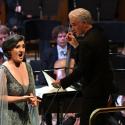Even the cold breeze along the Thames played its part in conjuring the chilly, epic Finnish landscapes of Jean Sibelius last night, though Finnish maestro Osmo Vänskä and the perfectly weighted phrasing of the London Philharmonic Orchestra can take primary credit. It’s unusual to have a single-composer programme these days, but Vänskä justified his repertoire with a performance of taut, lyrical and evocative power, which connected and illuminated different areas, historical and generic, of Sibelius’ career.
From Smetana to Shostakovich, a school of broadly Romantic composers created musical landscapes freighted with nationalistic myth. Many of their works are still icons of national identity, and while, in Sibelius’ case, Finlandia is the pre-eminent example, the whole of last night’s programme evoked the geographical and psychological contours of his homeland. Sibelius drew on the Kalevala, the national epic of Finnish mythology, for the vaguely programmatic Lemminkäinen Suite; arguably, however, it was the pieces of the first half of the concert that offered the densest portrait.
The Bard, first in the programme though the last to be composed, is a gem-like eight minutes of concentrated atmosphere. Its power comes from the visionary range of orchestral colours Sibelius’ orchestration creates. Weeping violins, lugubrious viola, and darkly burnished brass are combined over an irregularly pulsing rhythm, and were aided by the beautiful definition of the orchestra’s phrasing. Unlike the Lemminkäinen Suite, there’s officially no story attached, though given the title, and the use of the bardic harp, various literary sources are alleged. But the dramatic outline of the piece, with its climax of tremolando strings and trombone, has a recognisable universality that needs no further explanation.
Sibelius’ Violin Concerto is recognised as one of the repertoire’s most virtuosic, and that’s in the composer’s revised, easier version. (Vänskä recorded the original version with Leonidas Kavakos in 1991, though the revised concerto is the standard.) French violinist Alexandra Soumm, a Radio 3 New Generation Artist from 2010 to 2012, is relatively fresh to the solo stage; her account of the concerto was overall a laboured affair, in which relationship between soloist and orchestra lacked the spontaneity and fluidity vital to make the piece breathe organically. Soumm had mastered the solo part, bristling monstrously with arpeggios and double-stopping, but her delivery couldn’t help sounding rather studied, as if too absorbed in the individual demands of the piece, occasionally snatching at some of the more technical passages and slowing over others, to participate in the dialogue with orchestra. Without her, the orchestra breathed freely.
Lemminkäinen himself sounds endearingly hapless: he’s speared to death by the Swan he is supposed to kill, only to have his mother sew him together
The Lemminkäinen Suite, subtitled Four Legends of the Kalevala, is an intriguing blend of epic and more homespun, Grimm-style fable, as much picaresque in its dappled orchestral colour and lopsided rhythms as it is folk-heroic. By the time he wrote The Bard, nearly 20 years later, Sibelius’ orchestral colouring was denser, and his control of atmosphere even more adept, yet across the register, from the rippling violins, evoking Lemminkäinen’s journey to a distant island happily populated by willing maidens, to the muscular, bronzed colouring of the lower strings and delightful cor anglais, intimating brooding landscape and mounting threat, these are deft and vivid portraits with a cinematic command of the sweeping contours of landscape and narrative. Lemminkäinen himself sounds endearingly hapless: he’s speared to death by the Swan he is supposed to kill, only to have his mother pick out the pieces of his dismembered corpse and sew them together. But he completes his journey in heroic E flat major, maidens, swans and the island of the dead negotiated successfully.
Vänskä cuts an unusual figure on the podium, vigorous and demonstrative, but not in the grandiose way of the great conducting egotists. Unlike Lemminkäinen, he’s unfailingly sure of foot in his negotiation of Sibelius’ delightfully variegated musical drama, and his directions were precise and endlessly alert to the fine variety of tone, dynamic and rhythm.















Add comment